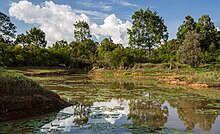







Karura Forest is an urban forest in Nairobi, the capital of Kenya. The forest was gazetted in 1932[1] and is managed by the Kenya Forest Service[2] in conjunction with the Friends of Karura Forest Community Forest Association.[3]
Karura Forest is 1,041 hectares (2,570 acres) consisting of three parts separated by Limuru and Kiambu roads. The large middle portion is ca. 710 hectares (1,800 acres); the Sigria salient to the west is ca. 250 hectares (620 acres). The portion to the east of Kiambu road has been allocated to special national priorities. As of mid-2016, 36% of the forest contains indigenous upland forest tree species. The forest is home to some 200 species of bird as well as suni, Harveys Duiker, bushbucks, bush pigs, genets, civets, honey badgers, bush babies, porcupines, Syke's monkeys, bush squirrels, hares, fruit bats, and various reptiles and butterflies. Karura now has over 50 km of trails for visitors to walk, run or bike.[4]
Due to its proximity to a growing city, there have been plans to reduce the forest in favour of housing and other development. However, these plans have been controversial with conservationists. In the late 1990s there were housing projects that would have excised portions of the forest. Conservationists, led by Wangari Maathai, the leader of Green Belt Movement who later became a Nobel Peace Prize Laureate, carried out a much publicised campaign for saving the forest. Karura Forest became also a symbol against controversial land grabbings in Kenya.[5]
- ^ UNEP: Kenya, Atlas of our changing environment – Chapter 5 Archived 15 February 2009 at the Library of Congress Web Archives Page 158
- ^ Kenya Forest Service: Securing Karura Forests Archived 26 July 2011 at the Wayback Machine
- ^ "Karura Forest » Secure, Safe, Serene". Archived from the original on 31 May 2012. Retrieved 4 May 2012.
- ^ "Friends of Karura Forest – Forest Map". Archived from the original on 28 January 2024. Retrieved 5 April 2017.
- ^ BBC News, 16 August 2010: Unprecedented move Archived 7 June 2014 at archive.today